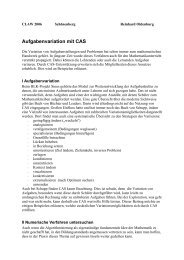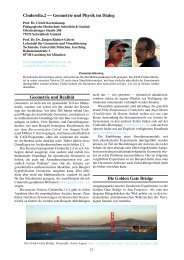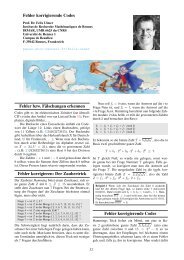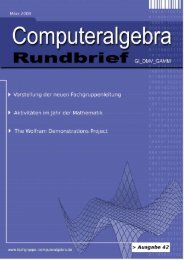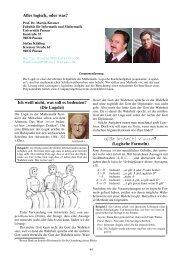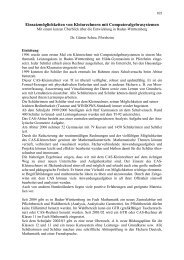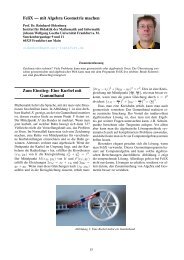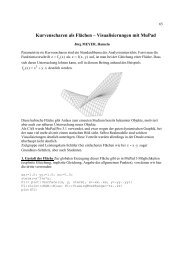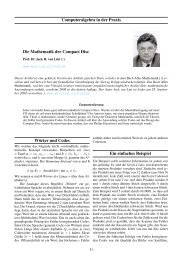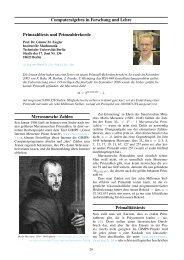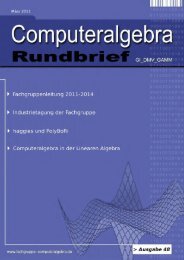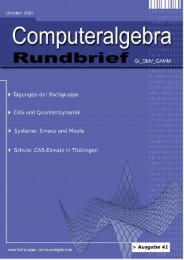Mathematica - Fachgruppe Computeralgebra
Mathematica - Fachgruppe Computeralgebra
Mathematica - Fachgruppe Computeralgebra
Sie wollen auch ein ePaper? Erhöhen Sie die Reichweite Ihrer Titel.
YUMPU macht aus Druck-PDFs automatisch weboptimierte ePaper, die Google liebt.
Themen und Anwendungen der <strong>Computeralgebra</strong><br />
PSLQ: An Algorithm to Discover<br />
Integer Relations<br />
David H. Bailey<br />
Lawrence Berkeley National Laboratory, Kalifornien<br />
Jonathan M. Borwein<br />
University of Newcastle, Callahan, New South Wales<br />
dhbailey@lbl.gov<br />
jonathan.borwein@newcastle.edu.au<br />
Introduction<br />
Let x = (x1, x2, · · · , xn) be a vector of real or complex<br />
numbers. x is said to possess an integer relation if there<br />
exist integers ai, not all zero, such that<br />
a1x1 + a2x2 + · · · + anxn = 0.<br />
By an integer relation algorithm, we mean a practical<br />
computational scheme that can recover the vector of<br />
integers ai, if it exists, or can produce bounds within<br />
which no integer relation exists. As we will see in the examples<br />
below, an integer relation algorithm can be used<br />
to recognize a computed constant in terms of a formula<br />
involving known constants, or to discover an underlying<br />
relation between quantities that can be computed to high<br />
precision.<br />
At the present time, the most widely used algorithm<br />
for integer relation detection is the “PSLQ” algorithm<br />
of mathematician-sculptor Helaman Ferguson [11, 4],<br />
although the “LLL” algorithm is also used for this purpose.<br />
One detailed comparison of these two methods<br />
found that PSLQ appears to be more numerically stable<br />
than LLL, in the sense that PSLQ reliably finds a relation,<br />
beginning nearly at the minimal precision level for<br />
the relation, whereas LLL sometimes finds a relation at<br />
one level but fails at a somewhat higher level [10]. This<br />
study also found that tuned implementations of PSLQ<br />
(which select multiple pairs of indices, and which employ<br />
two or three levels of precision [4]) are significantly<br />
more efficient than typical implementations of LLL.<br />
Additional research may further cast light on the relative<br />
merits of these two schemes. In the following, though,<br />
we will focus on PSLQ.<br />
PSLQ operates by constructing a sequence of<br />
integer-valued matrices Bn that reduces the vector y =<br />
xBn, until either the relation is found (as one of the columns<br />
of Bn), or else precision is exhausted. At the same<br />
time, PSLQ generates a steadily growing bound on the<br />
8<br />
size of any possible relation. When a relation is found,<br />
the size of smallest entry of the vector y abruptly drops<br />
to roughly “epsilon” (i.e. 10 −p , where p is the number of<br />
digits of precision). The size of this drop can be viewed<br />
as a “confidence level” that the relation is real and not<br />
merely a numerical artifact. A drop of 20 or more orders<br />
of magnitude almost always indicates a real relation (see<br />
Figure 1).<br />
Very high precision arithmetic must be used with<br />
PSLQ or any other integer relation scheme. If one wishes<br />
to recover a relation of length n with coefficients of<br />
maximum size d digits, then the input vector x must<br />
be specified to at least nd digits, and one must employ<br />
nd-digit floating-point arithmetic. Maple and <strong>Mathematica</strong><br />
include multiple precision arithmetic facilities and<br />
Maple ships with a full implementation of PSLQ. One<br />
may also use any of the several freeware multiprecision<br />
software packages, for example the ARPREC package<br />
by the first author and colleagues at LBNL [7]. In the<br />
remaining sections we describe various representative<br />
applications of PSLQ. More detail about these examples<br />
is given in [8] and the references therein.<br />
Finding Algebraic Relations Using<br />
PSLQ<br />
One immediate and impressive application of PSLQ in<br />
the field of mathematical number theory is to determine<br />
whether or not a given constant α, whose value can be<br />
computed to high precision, is algebraic of some degree<br />
n or less. This can be done by first computing the vector<br />
x = (1, α, α 2 , · · · , α n ) to high precision and then<br />
applying an integer relation algorithm to the resulting<br />
(n + 1)-long vector. If a relation is found for x, then<br />
this relation vector is precisely the set of integer coefficients<br />
of a polynomial satisfied by α (to the precision<br />
specified).<br />
One of the first results of this sort was the identification<br />
of the constant ˆ B3 = 3.54409035955 . . . .



